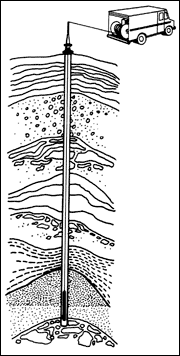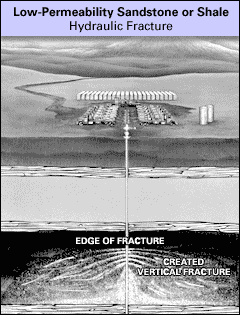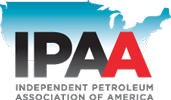Completion
Computer (Wireline) Logging

Natural Gas seldom shows itself in any dramatic way. It is elusive and hard to identify even after drilling through the target gas payzones. A “picture” is needed of what lies underground—where the drill bit has penetrated. To produce this “picture,” a technical measuring process known as Computer (Wireline) Logging is used.
Wireline logs were first developed by the Schlumberger Brothers in the 1920’s. Today, by building on the original concept, a much more sophisticated process has evolved. A specially equipped truck lowers an assembly of electronic sensing devices to the bottom of the hole. After the cable has touched bottom, it is then reeled in slowly so the underground instruments can measure various characteristics surrounding the wellbore. The printout (charts/graphs) generated in the computer truck is referred to as the “field print”.
Fracturing (“Frac”)

Many people think natural gas exists in large pools in underground cavities. Actually, gas is trapped in the pore spaces of certain rock formations: often limestone, sandstone or shale. One of the most important physical features of a gas reservoir is porosity—the amount of pore space in the formation available to hold natural gas. Another is permeability, the degree to which natural gas can move easily through the rock by means of interconnections among the pores.
Gas field developers like Blue Flame Energy can do little or nothing to improve porosity, but technologies are available to make it easier for gas to travel to the wellbore (permeability). The most common technological application to improve permeability is fracturing.
Fracturing (“Frac”)—treated fluids/gases are forced, under extreme pressure, into the producing formations, splitting open fissures in the rock and creating passageways for gas to flow back to the wellbore. Fracturing can be a very complex and expensive undertaking.
Royalty Owners | Operations: Drilling | Horizontal Drilling | Completion | Oil & Gas Revenue


